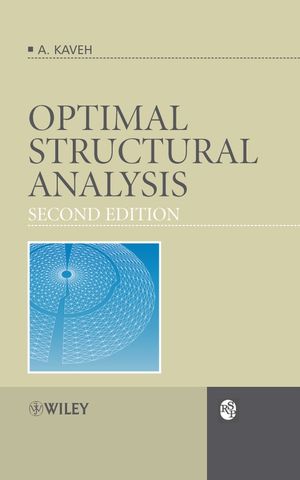Optimal Structural Analysis, 2nd EditionISBN: 978-0-470-03015-8
Hardcover
532 pages
August 2006
 |
||||||
Preface.
List of Abbreviations.
1. Basic Concepts and Theorems of Structural Analysis.
1.1 Introduction.
1.2 General Concepts of Structural Analysis.
1.3 Important Structural Theorems.
Exercises.
2. Static Indeterminacy and Rigidity of Skeletal Structures.
2.1 Introduction.
2.2 Mathematical Model of a Skeletal Structure.
2.3 Expansion Process for Determining the Degree of Statical Indeterminacy.
2.4 The DSI of Structures: Special Methods.
2.5 Space Structures and Their Planar Drawings.
2.6 Rigidity of Structures.
2.7 Rigidity of Planar Trusses.
2.8 Connectivity and Rigidity.
Exercises.
3. Optimal Force Method of Structural Analysis.
3.1 Introduction.
3.2 Formulation of the Force Method.
3.3 Force Method for the Analysis of Frame Structures.
3.4 Conditioning of the Flexibility Matrices.
3.5 Generalized Cycle Basis of a Graph .
3.6 Force Method for the Analysis of Pin-jointed Trusses.
3.7 Force Method Analysis of General Structures.
Exercises.
4. Optimal Displacement Method of Structural Analysis.
4.1 Introduction.
4.2 Formulation.
4.3 Transformation of Stiffness Matrices.
4.4 Displacement Method of Analysis.
4.5 Stiffness Matrix of a Finite Element.
4.6 Computational Aspects of the Matrix Displacement Method.
4.7 Optimal Conditioned Cutset Bases.
Exercises.
5. Ordering for Optimal Patterns of Structural Matrices: Graph Theory Methods.
5.1 Introduction.
5.2 Bandwidth Optimisation.
5.3 Preliminaries.
5.4 A Shortest Route Tree and its Properties.
5.5 Nodal Ordering for Bandwidth Reduction; Graph Theory Methods.
5.6 Finite Element Nodal Ordering For Bandwidth Optimisation.
5.7 Finite Element Nodal Ordering for Profile Optimisation.
5.8 Element Ordering for Frontwidth Reduction.
5.9 Element Ordering for Bandwidth Optimisation of Flexibility Matrices.
5.10 Bandwidth Reduction for Rectangular Matrices.
5.11 Graph-Theoretical interpretation of Gaussian Elimination.
Exercises.
6. Ordering for Optimal Patterns of Structural Matrices: Algebraic Graph Theory Methods.
6.1 Introduction.
6.2 Adjacency Matrix of a Graph for Nodal Ordering.
6.3 Laplacian Matrix of a Graph for Nodal Ordering.
6.4 A Hybrid Method for Ordering.
Exercises.
7. Decomposition for Parallel Computing: Graph Theory Methods.
7.1 Introduction.
7.2 Earlier Works on Partitioning.
7.3 Substructuring for Parallel Analysis of Skeletal Structures.
7.4 Domain Decomposition for Finite Element Analysis.
7.5 Substructuring; Force Method.
7.6 Substructuring for Dynamic Analysis.
Exercises.
8. Decomposition for Parallel Computing: Algebraic Graph Theory Methods.
8.1 Introduction.
8.2 Algebraic Graph theory for Subdomaining.
8.3 Mixed Method for Subdimaining.
8.4 Spectral Bisection for Adaptive FEM; Weighted Graphs.
8.5 Spectral Trisection of Finite Element Models.
8.6 Bisection of Finite Element Meshes Using Ritz and Fiedler Vectors.
Exercises.
9. Decomposition and Nodal Ordering of Regular Structures.
9.1 Introduction.
9.2 Definitions of Different Graph Products.
9.3 Eigenvalues of Graphs Matrices for Different Products.
9.4 Eigenvalues of A and L Matrices for Cycles and Paths.
9.5 Numerical Examples.
9.6 Spectral Method for Profile Reduction.
9.7 Non-Compact Extended p-Sum.
Exercises.
References.
Appendix A Basic Concepts and Definitions of Graph Theory.
A.1 Introduction.
A.2 Basic Definitions.
A.3 Vector Spaces Associated with a Graph.
A.4 Matrices Associated with a Graph.
A.5 Directed Graphs and Their Matrices.
A.6 Graphs Associated with Matrices.
A.7 Planar Graphs: Euler’s Polyhedron Formula.
A.8 Maximal Matching in Bipartite Graphs.
Appendix B Greedy Algorithm and its Applications.
B.1 Axiom System for a Matroid.
B.2 Matroids Applied to Structural Mechanics.
B.3 Cocycle Matroid of a Graph.
B.4 Matroid for Null Bases of a Matrix.
B.5 Combinatorial Optimisation: the Greedy Algorithm.
B.6 Application of the Greedy Algorithm.
B.7 Formation of Sparse Null Bases.
Index.
Index of Symbols.



